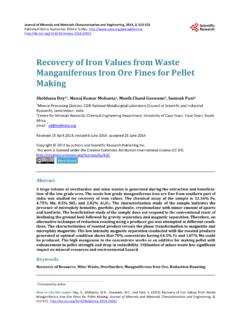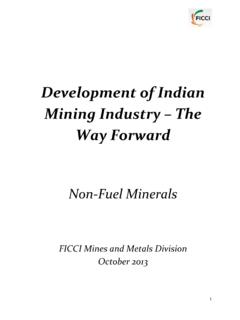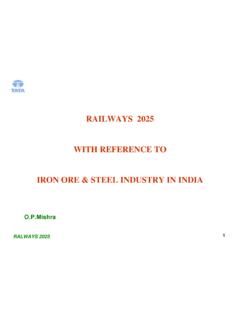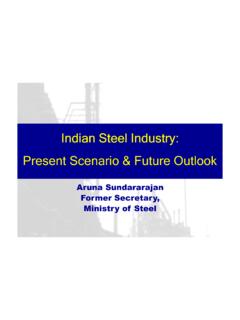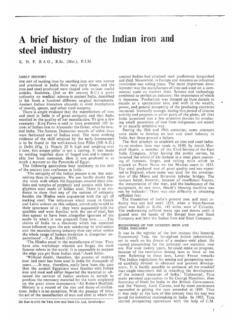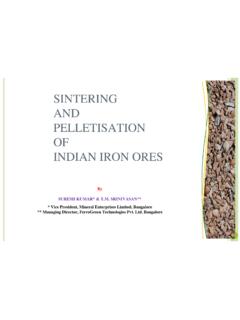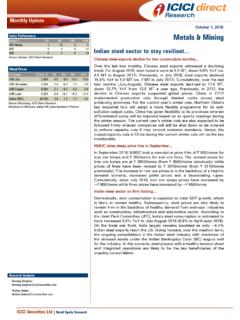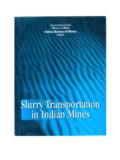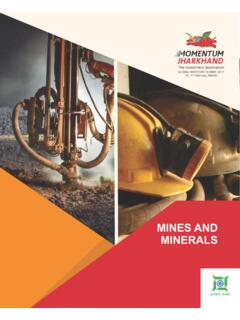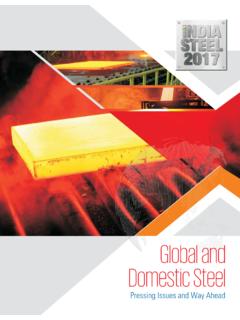Transcription of PROSPECTS FOR THE 2020 IRON ORE MARKET: HOW …
1 PROSPECTS FOR THE 2020 iron ORE market : HOW europe should PREPARE 1 PROF. DR. HAGEN LINDST DT QUARTERLY INSIGHTS ON STRATEGY AND market DYNAMICS PROSPECTS FOR THE 2020 iron ORE market : HOW europe should PREPARE S P O T L I G H T O N T H E I R O N O R E A N D S T E E L I N D U S T R I E S DECEMBER 2011 MARC P. BIELITZA, HAGEN LINDST DT Recent developments in the global iron ore market , driven primarily by the rapid industrialization of China, mark the beginning of deep changes in the structure and dynamics of the market and are putting steelmakers profitability at risk. Given iron ore's fundamental role in industrialized economies, European steelmakers and political leaders are seeking indications as to what direction the development of the iron ore industry will take in the coming years. Here s what they should do to protect the European industry from the harshest conse-quences.
2 PROSPECTS FOR THE 2020 iron ORE market : HOW europe should PREPARE 2 THE CHALLENGE I R O N O R E I S T H E B U I L D I N G B L O C K O F I N D U S T R I A L I Z E D E C O N O M I E S If DNA is the building block of life, then iron ore is the building block of the world's industrialized economies. As the key ingredient for steel-making, iron ore underpins almost all aspects of human activity, infra-structure and standard of living. From skyscrapers to beverage cans, from automobiles to heavy machinery, steel, and therefore iron ore, is omnipresent. iron ore may, in fact, be more integral to the global econ-omy than any other raw material, other than perhaps oil. Consequently, the market for iron ore is a market of superlatives. In 2009, almost billion tons of iron ore were mined around the world, enough to make roughly 14,000 times the amount of steel used to build San Francisco's Golden Gate Bridge.
3 The iron ore mined and sold in 2009 had a total market value of roughly USD 140 billion, equivalent to almost 5% of the German GDP and only slightly less than the total market value of the entire real estate in Manhattan. The extremely capital-intensive iron ore mining business has traditional-ly been dominated by three mining conglomerates: Vale, Rio Tinto and BHP Billiton. These companies, known as the Big Three , controlled approximately one third of global iron ore production in 2009. Recently, the iron ore market has undergone various radical changes, driven primarily by a global demand shock caused by the rapid industrialization of China. FIGURE 1: GLOBAL CRUDE STEEL PRODUCTION AND iron ORE COST OF EUROPEAN STEELMAKERS, 1980 - 2009 PROSPECTS FOR THE 2020 iron ORE market : HOW europe should PREPARE 3 C H I N E S E D E M A N D B O O M H A S L E A D T O R A D I C A L C H A N G E S Within just a few years, surging construction and infrastructure invest-ments have transformed China into the by far largest steel producing economy in the world and, due to the low quality of its domestic iron ore resources, the major buyer of iron ore.
4 In combination with sustained economic growth in the other BRIC countries, this immense increase in iron ore demand has led to an iron ore price supercycle that was only temporarily suspended by the financial crisis and is now picking up again (see Figure 1). As a result, steelmakers find themselves confronted with a price-cost squeeze that is threatening their profi-tability. For decades, the iron ore market was characterized by its stability, founded on the benchmark pricing mechanism. Prices were determined in lengthy annual negotiations between miners and steelmakers in europe and developed Asia. As a consequence of the prevailing market forces, the system was replaced by a quarterly index-based pricing model in early 2010. The new model operates on the basis of the average spot price for iron ore supplied to China, quoted in a regularly published iron ore index.
5 Consequently, iron ore price dynamics are now experiencing ever shorter cycles and greater volatility. THE RESPONSE G L O B A L I R O N O R E M A R K E T M O D E L ALL O W S A N A L Y SIS O F D E V E L O P M E N T S Projection of future market developments is always a hazardous exer-cise. The enormous difficulties inherent in quantitative forecast make it tempting to avoid numbers and simply make purely qualitative state-ments on major tendencies. However, there can be little doubt that, despite their limitations, numerical, model-based forecasts, set along-side qualitative discussions, permit a more focused examination of future developments. To this avail, we have developed a model of the 2020 iron ore market . Based on the fundamental mechanics of the market and including de-tailed capacities and costs for 640 individual mines and brown/greenfield expansion projects, the deterministic nine-region spatial equilibrium model is capable of forecasting 2020 production volumes, interregional trade flows, regional market prices and market participants payoffs for a number of relevant scenarios.
6 With all the necessary qualifications to the accuracy and reliability of the model, Figure 2 gives an overview of the iron ore trade flows and market prices derived for the 2020 base case. The following general market characteristics can be assumed: PROSPECTS FOR THE 2020 iron ORE market : HOW europe should PREPARE 4 2 0 2 0 I R O N O R E M A R K E T I S C H A R A C T E R I Z E D B Y H I G H P R I C E S A N D V O L A T I L I T Y Increased global demand It is probable that the 2020 iron ore market will be characterized by considerably higher global demand than today. The booming economies of China, South America and India with their immense hunger for steel will constitute the nucleus of future iron ore demand. Increased global production capacity The demand surge is likely to be compensated by considerably higher global iron ore production capacities, stemming from numerous green- and brownfield expan-sion projects, especially in South America and Oceania.
7 With its high-quality and thus low-cost ore resources, Africa is expected to establish itself as the indisputable number three supplier. Increased seaborne trade flows In terms of iron ore trade, it can be expected that the main flows will be directed from the three largest supplying regions to China and the remaining Asian economies. This effect will be reinforced by a considerable decrease in China's domestic iron ore production due to depletion of mines and the presence of lower-cost production capacity abroad. More volatile market prices at high level For most regions, market prices are predicted to be at or only slightly below the 2009 level. As a result, steelmakers raw material costs will continue to make up a significant portion of the final steel price, forcing mills to face a sus-tained price-cost squeeze. Due to the new spot market -linked pricing mechanism and emerging speculation effects, market prices will also become more volatile.
8 FIGURE 2: iron ORE TRADE FLOWS AND REGIONAL market PRICES, 2020 BASE CASE PROSPECTS FOR THE 2020 iron ORE market : HOW europe should PREPARE 5 E U R O P E A N S T E EL-M A K E R S F A C E C O N S I D E R A B L E R I S K S From a European perspective, this represents a gloomy outlook. Steel-makers will be forced to cope with continuously high base-level iron ore prices as well as increased short-term price fluctuations. In addition, they will find themselves exposed to considerable price risks arising from global supply and demand levels as well as resource nationalism: Level of global capacity utilization Analyses show that the European iron ore price in 2020 depends greatly on the prevailing ratio of global iron ore demand to available mining capacity. As displayed in Figure 3, the European market price is positively correlated with global capacity utilization, increasing disproportionately when utiliza-tion exceeds a critical limit of approximately 90%.
9 iron ore export restrictions High iron ore prices have lead to a re-surgence in resource nationalism as governments are rediscovering the security of raw materials supply as a key part of their strategic agenda. Particularly export restrictions are becoming increasingly fashionable . India is one of the frontrunners, having recently raised its iron ore export tax to 20%. Also, in an effort to expand domestic steelmaking and thus to reduce reliance on natural resource exports, Brazilian policy makers are debating the introduction of a 5% export tax on iron ore. Figure 4 shows the effect of export tax levels in Brazil and India on the European iron ore price in 2020. FIGURE 3: 2020 EUROPEAN market PRICE AS A FUNCTION OF GLOBAL CAPACITY UTILIZATION PROSPECTS FOR THE 2020 iron ORE market : HOW europe should PREPARE 6 E U R O P E S H O U L D EN C O U R A G E L I Q U I D I T Y A N D F R E E T R A D E Domestically produced steel is of significant strategic importance for europe s industrial core.
10 Therefore, europe should seek to protect its steel industry from the harshest consequences of these global develop-ments by shaping and implementing strategies to mitigate the risks arising from the new market situation: Encourage high liquidity in global iron ore supply iron ore miners, especially the Big Three, have a significant collective incentive to keep the market tight, preferably above a global capacity utilization of 90%, where prices would skyrocket. While it is not probable that iron ore miners will cut capacity at mines in operation, the major iron ore miners have enough leverage to keep global supply low by delay-ing expansion projects. europe should in turn aim to influence global capacity utilization to its favor by encouraging the buildup of addi-tional iron ore production capacity beyond the reach of the Big Three. europe can thereby follow the example of China, which is already extremely active in funding junior miners' expansion projects and de-veloping own iron ore mining projects around the globe.
